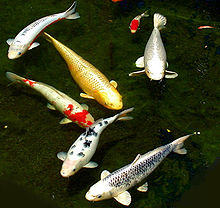
You have to admire the ingenuity of the early Japanese koi fish breeders.
They took an ordinary fish with one or two colors and selectively bred the wide variety of colors and patterns that make up the koi standards of today and created a whole industry based on a common carp. They created colors of brilliant reds, blacks and green with some yellow and the ever popular white.
Most koi have a base of white, with spots or patches of other colors. Red and Black patterns are more common, with solid colors being more rare and unique. So, what makes the white koi so popular? Is it just because it makes a wonderful contrast to other colors, or is it something else?
I don’t know the answer to that question, but I do know they are a unique color and sometimes appear to shine like platinum when they are solid white. Fish that are one color have become popular with koi keepers and some appear to have metallic looking scales that makes them even more lustrous than some of their other cousins.
Each variety of koi has a certain standard and classifications they fall into. But, unless you are into raising koi, you probably won’t be able to recognize all of them. The two most popular varieties are white koi with red markings called the Kahaku in Japanese and the other is only one color, usually a yellow or white, called the Ogon variety.
Sometimes the solid color fish seem plain and over the years, large fins have become desirable as a way of offsetting the plainness of their bodies. No matter what the color is or the variety, the color of a Ogon koi should be the same from their heads to their tails and all the way down to the tips of their fins.
White koi have the added attraction of being a hardy and fast growing fish that stand out well in ponds that have murky water and poor filtering systems. The Ogon variety also include others such as the Nezu, Orenji and the Fuji koi fish.
Every koi owner wants to show off his fish. And one thing that really encourages pond owners to put in lots of koi is the large variety of colors these fish come in. They show off their best colors and are always viewed best when looking down on the pool. The reason is fairly simple, most of their color pigments are on the top of the fish. This is also the reason the fish are shown in in round pools and viewed from the top at events around the world.
Getting the best information about koi fish colors and deciding which variety you want to keep is the first step toward having a great Koi fish pond. Get all the answers you need about koi colors from the experts in the “The Beginner’s Guide to Raising Healthy Koi“.
CLICK HERE to get your own copy of this unique book and learn how to raise healthy beautiful white koi.